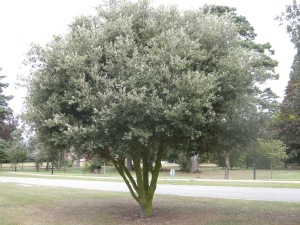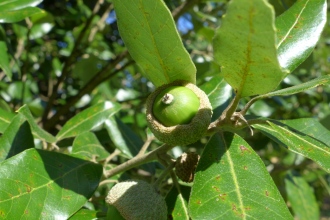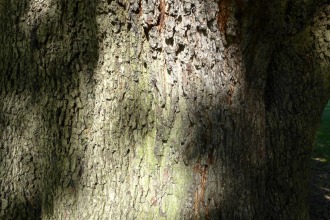Position: Full sun to partial shade
Soil: Free draining soil
Flowering period: Spring
Eventual Height: 25m
Eventual Spread: 20m
Hardiness: 7a, 7b, 8a, 8b, 9a, 9b, 10a, 10b, 11
Family: Fagaceae
Quercus ilex is an medium sized evergreen tree eventually forming a bell shape. Its evergreen leaves are leathery, are dark green above and whitish below with dense short hairs on the underside. The leaf shape is variable and are up to 8cm long and 3cm wide when mature. The leaves on the lower branches are often larger and spiny. Old leaves fall 1 – 2 years after new leaves emerge. Its bark is black and finely cracked. The tree produces yellow catkin flowers in spring followed by acorns which mature in about six months.
Quercus ilex, commonly known as Holm Oak or Holly Oak, is native to the Mediterranean region of Europe. It takes its common name Holm from an Anglo-Saxon name for Holly. Quercus ilex is not native to the UK and was introduced in the 1500s, it is now listed as an alien invader species and it is proposed that it should be included on Schedule 9 of the Wildlife and Countryside Act.
The etymological root of the binomial name Quercus is the ancient Latin name for an oak tree but some authorities believe it to be derived from the Celtic quer meaning ‘fine’ and cuez meaning ‘a tree’. Ilex is from the Latin for holly referring to this trees juvenile leaves often being similar to that of Holly.
The Landscape architect may find Quercus ilex useful as an evergreen specimen tree which is tolerant of pollution. It may be used as an evergreen hedging species and is suitable for the maritime climate. This tree will not tolerate cold continental winters.
Quercus ilex will tolerate most soil conditions; it will be happy in acid, neutral or alkaline pH levels and will tolerate very alkali soils. I thrives in sandy, loamy or clay based soils and will even tolerate heavy clay soils.
The Royal Horticultural Society gave Quercus ilex their prestigious Award of Garden Merit in 1993.
Ecologically, Quercus ilex is valuable to birds to provide shelter and nesting sites. The acorns also provide a source of food for a wide variety of animals. Quercus ilex is one of the top trees for establishing a truffle orchard as the truffles grow in an ectomycorrhizal association with the tree’s roots.
Quercus ilex requires little maintenance. Dead or damaged material may be removed in late autumn through winter. When maintaining this tree as a hedge it should be trimmed once a year in the winter months.










Leave a comment